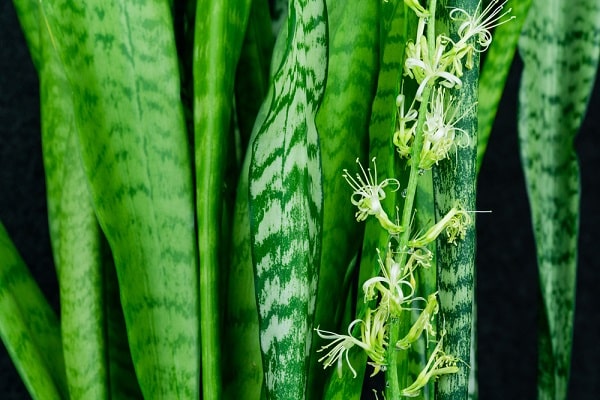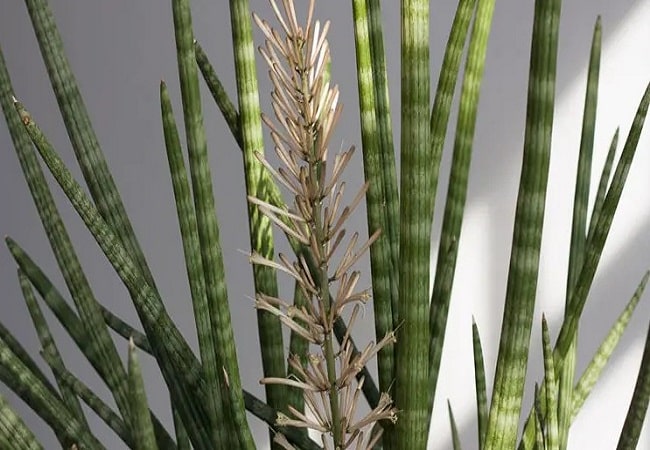Snake plants, known for their resilience and striking appearance, have become popular among indoor enthusiasts. Often referred to by their scientific name, Sansevieria, these plants boast tall, sword-like leaves with unique patterns that make them a visually appealing addition to any space.
A lesser-known but equally fascinating aspect of snake plants is their blooming behavior. This article will delve into how often do snake plants bloom snake plants bloom, discussing how often these hardy plants produce flowers and what factors can influence their blooming frequency. Join us as we uncover the enigmatic flowering habits of these stunning houseplants.
Quick Navigation
How Often Do Snake Plants Bloom?

Snake plants are not known for their blooms as much as their attractive foliage. Nonetheless, these plants occasionally produce flowers, offering a pleasant surprise to their owners. However, the blooming frequency of snake plants can be quite sporadic and is influenced by various factors. In this overview, we’ll look closer at snake plants’ typical annual blooming cycle and the environmental and other factors that can impact their flowering patterns.
Unlike many other plants, snake plants do not have a fixed annual blooming cycle. While some might bloom yearly, others can go several years without producing flowers. Blooms typically emerge as a surprise, with fragrant, white, or cream-colored flowers appearing on a long flower stalk, usually during late spring or summer.
Light
Snake plants prefer bright, indirect light, which can encourage blooming. However, they can also tolerate low light conditions but may be less likely to produce flowers in such an environment.
Temperature
These plants thrive between 70-90°F (21-32°C). Providing a consistent, suitable temperature range can increase the chances of blooming.
Humidity
Snake plants tolerate various humidity levels but prefer moderate humidity. Maintaining a balanced humidity level promotes flowering.
Plant Age
Mature snake plants are more likely to bloom than younger ones. A snake plant may take a few years to mature and produce its first flowers.
Proper care
Ensuring your snake plant receives adequate care, including proper watering and fertilizing, can increase its overall health and the likelihood of blooming.
Stress
Interestingly, some snake plants may bloom as a stress response. Underwatering, root-bound conditions, or sudden environmental changes can trigger flowering.
The blooming frequency of snake plants can be quite unpredictable. While environmental and other factors can influence their flowering patterns, there is no surefire way to guarantee blooms every year. However, by providing proper care and maintaining optimal conditions, you can increase the chances of witnessing the beautiful and rare sight of a snake plant in bloom.
Environmental Factors Affecting Snake Plant Blooming

Environmental factors play a meaningful role in determining the blooming frequency of snake plants. By understanding the impact of these factors and providing the appropriate conditions, you can help improve the entire health of your snake plant and increase the chances of it producing flowers. The three key environmental factors affecting snake plant blooming are light requirements, temperature preferences, and humidity.
Light Requirements
Snake plants are known for their capability to thrive in various light conditions. However, for optimal growth and to encourage blooming, they prefer bright, indirect light. Placing your snake plant near a window with filtered sunlight or in a well-lit room can help promote flowering. It is essential to avoid exposing the plant to state sunlight for prolonged periods, as this can cause the leaves to scorch. While snake plants can tolerate low light conditions, they are less likely to bloom in such environments.
Temperature Preferences
Temperature plays a crucial role in snake plants’ overall health and blooming. They thrive in temperatures ranging from 70-90°F (21-32°C). Consistently maintaining this temperature range can help improve the plant’s overall well-being and increase the likelihood of blooming. It is essential to avoid exposing snake plants to temperatures below 50°F (10°C) or sudden temperature fluctuations, as these conditions can cause stress and negatively impact the plant’s health.
Humidity Levels
Snake plants are tolerant of various humidity levels, but they generally prefer moderate humidity. convinced a balanced humidity level in your home can help delevaring healthy growth and flowering in snake plants. Too low humidity can cause the plant’s leaves to dry out and curl, while excessive humidity can lead to fungal infections and various issues . To making optimal humidity levels, consider using a humidifier or placing a water tray near the plant to create a more humid microclimate.
By providing the right environmental conditions for your snake plant, including adequate light, suitable temperature, and balanced humidity levels, you can help improve its overall health and increase the chances of witnessing its rare and beautiful blooms.
An Annual Blooming Cycle Of Snake Plants

Snake plants, while primarily valued for their attractive foliage, occasionally produce blooms that can delight their owners. However, the annual blooming cycle of snake plants is notably inconsistent and unpredictable. This section will discuss the variability in snake plant blooming patterns and the typical blooming season.
Inconsistency In Annual Blooming Patterns
Like many other plants, snake plants do not have a fixed annual blooming cycle. Some snake plants might bloom yearly, while others can go several years without producing any flowers. This inconsistency in blooming patterns makes it difficult to predict when or if a snake plant will bloom. Environmental conditions, plant age, and overall health can influence the likelihood of a snake plant producing flowers, but annual blooms are not guaranteed.
Typical Blooming Season
When snake plants bloom, they usually produce flowers in late spring or summer. The blooms are often fragrant, white, or cream-colored and appear on a long flower stalk, which can emergency from the base of the plant. These flowers generally last for a short period, making the sight of a blooming snake plant even more special and rare. Although late spring and summer are the most common blooming seasons, some snake plants may flower at other times of the year, depending on the specific conditions in which they are grown.
The annual blooming cycle of snake plants is characterized by unpredictability and inconsistency. While some plants may bloom yearly, others might not produce flowers for several years. The typical blooming season for snake plants is late spring or summer, but this can vary depending on the plant’s environment and care. Providing optimal growing conditions and proper care can improve the overall health of your snake plant and increase the chances of witnessing its elusive and enchanting blooms.
FAQs
What Is The Best Environment For Snake Plant Blooms?
The best environment for snake plant blooms includes bright, indirect light, temperatures between 70-90°F (21-32°C), and moderate humidity. Providing these optimal conditions can improve the overall health of the snake plant and increase the likelihood of blooming.
Can Snake Plants Bloom More Than Once Per Year?
While it’s uncommon, snake plants can occasionally bloom more than once per year, depending on the specific growing conditions and overall plant health. However, most snake plants will bloom only once yearly or less frequently.
Do All Snake Plants Bloom?
Not all snake plants will bloom, as their blooming patterns are unpredictable. Age, environmental conditions, and overall health can influence whether a snake plant produces flowers. Some plants may never bloom, while others might bloom every few years or more frequently.
How Can I Encourage My Snake Plant To Bloom?
To encourage your snake plant to bloom, provide optimal environmental conditions, including bright, indirect light, suitable temperature, and moderate humidity. Ensure proper care by watering appropriately, fertilizing during the growing season, and regularly observing your plant for signs of stress. While there is no guarantee to make snake plants bloom, following these guidelines can improve their overall health and increase the likelihood of witnessing their rare blooms.
What Happens After A Snake Plant Blooms?
After a snake plant blooms, the flowers will eventually wither and die. The flower stalk can be removed once it has dried out, as it will not produce more flowers. Removing the spent flower stalk helps maintain the plant’s appearance and redirects energy toward the overall health and growth of the plant. It’s essential to continue providing proper care and optimal conditions to ensure your snake plant remains healthy and has the potential to bloom again.
Conclusion
The blooming frequency of snake plants is characterized by its unpredictability and inconsistency. While these hardy plants are primarily valued for their stunning foliage, their blooms offer a rare and captivating sight to plant enthusiasts. There is no fixed annual blooming cycle for snake plants, and various factors, including environmental conditions, plant age, and overall health, can influence their blooming patterns.
Although it’s impossible to guarantee annual blooms, by providing optimal growing conditions, ensuring proper care, and closely observing your snake plant’s response, you can improve its overall health and increase the chances of experiencing the enchanting beauty of its flowers. Remember, patience is key in snake plant blooms, but the reward of witnessing their delicate, fragrant flowers is well worth the wait.

My name is Md Deloar Hossain and I’m the creator of Club Gardening, designed for all your gardening ideas, gardening product reviews, and a place to help you find the best gardening experience possible.


